WARM UP
Stretch and Roll Out:
Calves
Hamstrings
Quads
Hips/Glutes
Chest
Back
ACTIVATION
Complete 5-6 round of the Inchworm Flow.
WORKOUT
Set a timer for 10 minutes. Complete as many rounds of each circuit in that time as you can. Rest only as needed.
CIRCUIT #1:
10 calorie Row
10 reps Med Ball Squat and Throw
10 reps Squat Jumps
10 reps Sit Ups
CIRCUIT #2:
5 reps Med Ball Burpees
10 reps Inverted Rows
15 reps Kettlebell Swings
20 reps Double Unders
CIRCUIT #3:
10 reps Rainbow Split Squat Jumps
10 reps Push Ups
10 reps Plank Jacks
10 reps Alternating Leg V-Ups
COOL DOWN
Stretch and Roll Out:
Calves
Hamstrings
Quads
Hips/Glutes
Chest
Back
NOTES:
Your goal is to do as many rounds as you can in the 10 minutes, which means resting as little as you can. Lower reps, change variations or even weights if you find you are doing more resting than working. It is ok to have to pause briefly because you are challenging yourself, but you don’t want to spend most of your time resting!
EXERCISE DESCRIPTIONS:
Row – Change the setting on your rower to calories and pull as hard and as fast as you can until 10 calories are completed. If you don’t have a rower, you can use another piece of equipment or even sprint outside. Keep the sprint to 15-20 seconds.
Med Ball Squat and Throw – To do the Squat and Throw, hold a med ball in both hands at your chest and stand with your feet about hip-width to shoulder-width apart. You can stand facing a way to throw up at or you can simply throw up toward the ceiling. Then squat down with the ball at your chest. As you explode up out of the squat, press the ball from your chest throwing it as high up as you can. It is ok to explode out of the squat and jump as you throw the ball from your chest up as high as possible. Make sure that as you throw you extend your body and your arms up toward the ball. Then catch the ball either straight off the throw or after a bounce on the ground and sink right back into the squat and repeat. Do not round forward as you sink into the squat while holding the ball at your chest. This also doesn’t have to be a squat where you sink your butt all the way to the ground, but you do want to make sure to sit your butt back and down. Throw the ball as high as you can. Add weight if you can easily throw it super high or as high as your space allows!
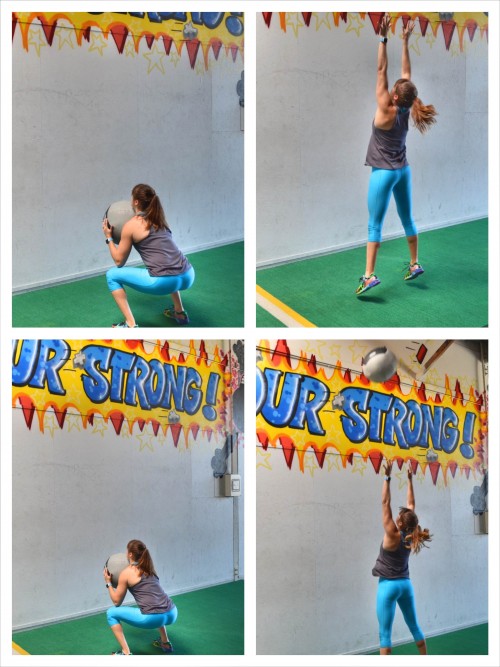
Squat Jumps – To do Squat Jumps, stand with your feet between hip-width and shoulder-width apart. Sit your butt down and back into as low a squat as you can with good form (aka your heels stay down and your chest stays up and your knees don’t cave in). You can then swing your arms back as you squat or reach your hands down to touch the ground. Then explode up out of the squat and jump as high off the ground as possible. You can swing your arms and reach your hands overhead to help propel you up. As you jump, extend your body fully. As you land, sink right back into the squat so you can explode right back up. Do not land with your legs straight. Make sure to bend your knees as you land and try to land softly to protect your knees. Beginners may need to rest between each rep; however, that doesn’t mean landing with your legs straight. You should never land with your legs completely locked. Bend your knees to help you absorb the impact of landing even if you pause between jumps. Beginners can also start with a quick Basic Bodyweight Squat and even come up onto their toes as the stand up instead of completely leaving the ground. If they have good mechanics, they may want to leave the ground but not jump as high. To make the move harder, jump up and sink right back into the squat to repeat as quickly as possible. Really focus on a soft landing and then exploding quickly into as high a jump as you can.
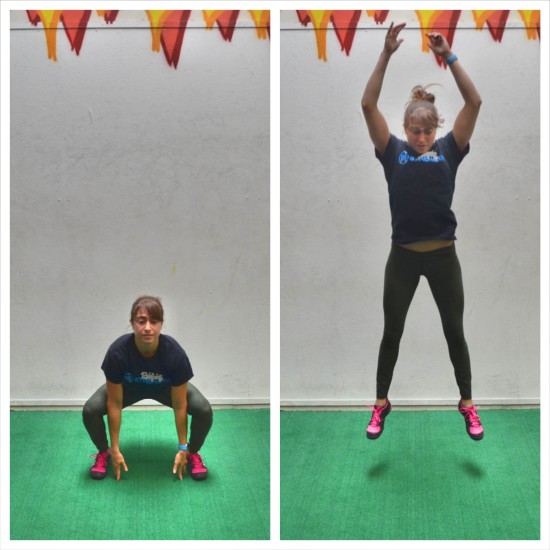
Sit Ups – To do the Full Sit Up you can reach up overhead or toward your toes. To do it with a reach toward the toes, lie back on the ground with your legs out straight and your arms overhead. You can also reach your arms up toward the ceiling if you want to limit the assistance you get from “swinging” your arms. Then roll to sit up, first lifting your shoulder blades then the rest of your spine and finally your low back. As you “roll” up, reach your hands forward and toward your feet. Then lie back down, reaching your arms back overhead. Repeat, sitting back up. If you struggle to sit up, you can hold light weights in your hands. The weights actually can make it easier.
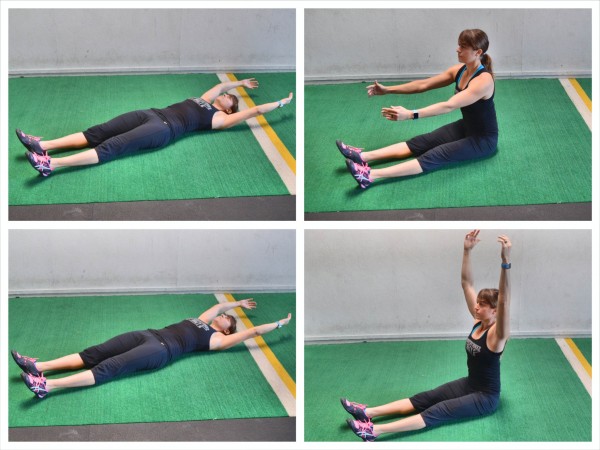
Med Ball Burpees – To do the Med Ball Burpee, start standing, holding the ball in both hands. Choose a weight light enough that you can move quickly and slam the ball powerfully. Reach the ball up overhead, extending your body as you reach your arms back and overhead. Then slam the ball down as hard as you can into the ground, hinging over and sitting your butt back as you slam while following through with your arms. As you hinge over, bend your knees. After slamming the ball, quickly place your hands on the ground and jump back into a high plank position. When you jump back, make sure to keep your body in a nice straight line. Then jump your feet back in toward your hands so that you are squatting to pick up the ball. Pick up the ball and reach back overhead, extending your body and standing up nice and tall. Then repeat the slam and burpee. Make sure to use your legs to lift and slam. Do not just round your back to pick the ball up. Slam the ball as hard as you can each and every time. Do not simply drop the ball. Beginners will want to use a lighter ball and may step back into the plank position instead of jumping back.
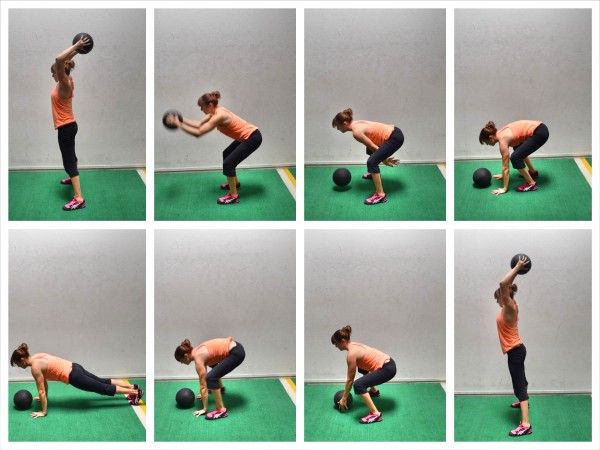
Inverted Rows – To do the Basic Inverted Row, you can either use a Suspension Trainer or a Bar. Using a Suspension Trainer, hold a handle in each hand with your palms facing in. Walk your feet forward so that your body is at an incline. The closer to parallel to the ground you get, the harder the move will be. Hang from the straps with your body in a nice straight line and your chest pressed out. Engage your core and glutes and keep your legs straight. You want a nice straight line from your head to your heels. Do not let your low back arch or your hips sag toward the ground. Then drive your elbows down and back to row your chest up to the handles. Keep your body in a nice straight line as you row up and do not bounce off the bottom. Keep your wrists straight as you row up. Also, do not shrug your shoulders. Then lower back down. Do not lose tension at the bottom. Make sure to keep the chest pressed out and your body in a nice straight line. Do not swing to row back up. Make sure to feel your back and arms working to row and not just your arms. Focus on feeling your back pull.
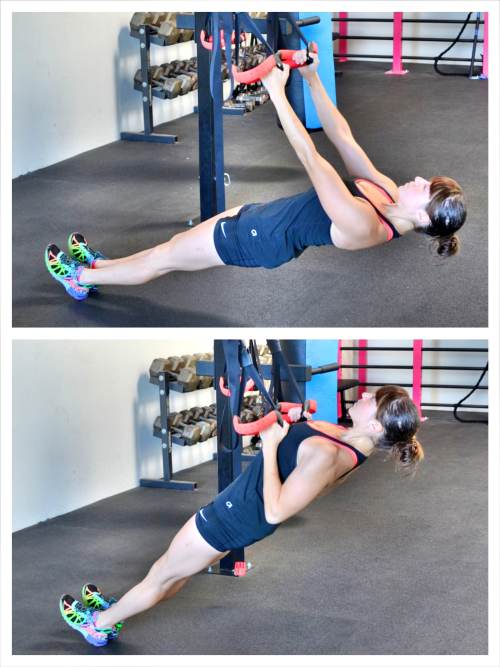
Kettlebell Swings – To do the Kettlebell Swing, set the kettlebell (or bell) down on the ground and slightly in front of you. Hinge over, bending your knees slightly and pushing your butt back as you lean forward. Keep your back flat and then reach your arms out and place both hands on the handle, tilting the bell back toward you.Hike the kettlebell back between your legs like you would a football. Pull it back and up between your legs toward your butt. To power the bell up and forward, squeeze your glutes and drive your hips forward as you stand up nice and tall. Pop your hips forward and propel the kettlebell up off your hips. Do not worry about how high the bell goes. It shouldn’t go higher than your shoulders. Squeeze your glutes as you stand tall. You may lean back a little at the top, but make sure you are squeezing your glutes and not loading your low back. Then, keep your glutes tight, wait as the bell comes back down before you hinge back over. Your forearms need to connect with your hips before you hinge back over and bring the bell back down and through your legs. Do not lean forward and hinge over before the kettlebell comes back down. You want to maintain the connection between your hips and forearms to protect your low back. Also, don’t allow the kettlebell to sink low between your legs. You want the bell up close to your crotch. As your forearms connect and you hinge over, sitting your butt back, make sure to lean forward to counterbalance the kettlebell going back through your legs. Let the kettlebell reach through toward the wall behind you. If the bell comes up and taps you in the butt, it may be too light. Then squeeze your glutes again and thrust the kettlebell back up as you come back up to standing. With the swing, you may keep a straighter leg or bend your knees a little as you swing. They are both acceptable just different styles. Make sure to squeeze your glutes at the top of each swing and make sure you don’t come up onto your toes. While you may lean back a little, you don’t want to lean back and load your low back. You should not feel this move in your low back at all. Maintaining the connection between your forearms and hips as you hinge is essential for keeping your glutes working and your low back from feeling strained. Do not sit your butt back while the kettlebell is still out in front of you. You almost want the kettlebell to be pulling you back and that is why you are hinging over. The hinge is a reaction to the bell instead of you anticipating the kettlebell coming back down and hinging over before it lowers. Start small with the swing to focus on the connection. You don’t have to get the kettlebell all the way up to your chest to get a lot out of the movement.
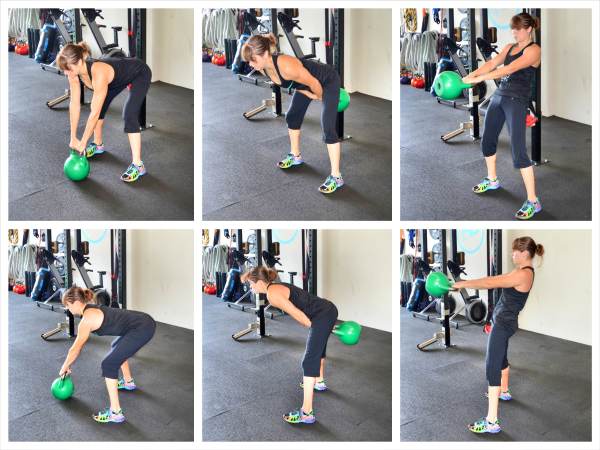
Double Unders – To do Double Unders, hold an end of the jump rope in each hand. You may then want to start with a few basic jump rope jumps before beginning Double Unders. Then begin to spin the rope faster to spin the rope twice under your feet as you jump up. You may want to jump a bit higher as you begin to learn the Double Under. However, you do not want to spend a ton of energy jumping extra high with each Double Under. Instead you want to work on spinning the rope faster as you stay relaxed and jump only as much as needed. Beginners will need to start by spinning the rope faster and potentially jumping higher. They can even begin to learn the Double Under by performing a Tuck Jump. As you do Double Unders, stay up nice and tall and really spin the rope quickly using your wrists while keeping your shoulders relaxed down and back as much as possible. You can also do jumping jacks or basic jump rope to regress.
Rainbow Split Squat Jumps – To do Rainbow Split Squat Jumps, step one foot forward so you are in a nice wide stance. Hold the ball in both hands and bring it outside that front leg. Sink into a deep lunge, bending the back knee down toward the ground as you bend the front knee. Bring the ball outside your front hip. Then jump up and as you do switch your legs so that you land with the opposite leg in front. As you jump and switch legs, swing the ball up overhead and down outside the other hip. When you land and bring the ball outside your other hip, sink straight into a lunge on the other side. Then jump back into a lunge on the first side, swinging the ball in a rainbow overhead and down to the other hip. Move quickly and try to get up off the ground. Get as deep in the lunges as you can as well. Make sure though that you don’t start to go forward, but land and sit back in the lunge a bit. Beginners may not be able to sink as low in the lunge and may need to do more of a step back with a hop instead of a jump from lunge to lunge.
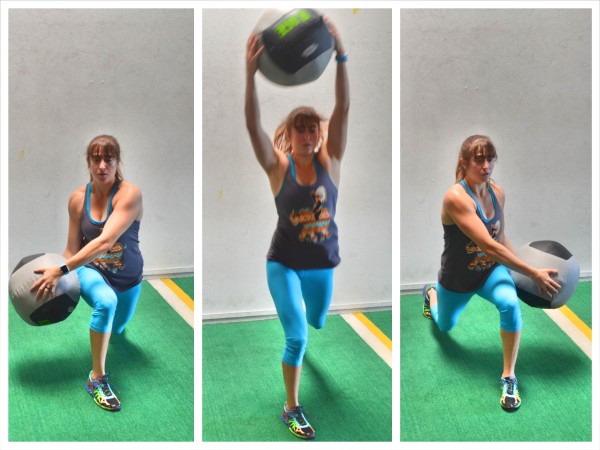
Push Ups – To do the Basic Push Up, set up in the high plank position with your hands under your shoulders and your arms locked out while your feet are together and your body is in a nice straight line from your head to your heels. Make sure you can drive back through your heels and that your feet aren’t too far back so that you are up on your toes. Squeeze your glutes and legs together as you brace your abs and drive back through your heels to engage your legs (especially your quads). You want to make sure to squeeze your legs together to help hold your body in a nice straight line. By squeezing your legs together, your adductors will engage. By engaging your core before you even lower, your hips shouldn’t drop toward the ground and your butt shouldn’t go up in the air toward the ceiling as you perform the Push Up. By engaging your core before you do the Push Up, you will help your body move as one unit. Make sure that as you set up, your head isn’t tucked toward the ground or jutting forward. Your back should also not be excessively arched or rounded. Your body should be in a nice straight line with your core engaged. While in the high plank position, remember your hands should be below your shoulders and right outside your chest. Your finger tips should be pointing straight ahead and your hands should be pressing into the ground and away from each other as if trying to tear a piece of paper between them. You can play around with exact hand with to place more emphasis on different muscles. As you lower down to do the Push Up, you should lower your chest directly between your hands, keeping a nice straight line with your body. Your elbows shouldn’t flare out from your body. Your elbows should make an arrow shape with your body. Like this (–> ). You do not want your arms to create a “T” with your body or you will put more strain on your shoulders and risk injury. You also don’t need to keep your arms right in by your sides unless you want to work more tricep. Your shoulders, elbows and wrists should all be in a straight line as you lower. Your body should move as one unit toward the ground. Touch your chest to the ground when you lower with everything moving together. Hips shouldn’t move back up first or touch the ground first. Your head also shouldn’t jut forward as you lower and lift. Everything should move as one without your hips sagging or your elbows flaring out as you lower or lift. Keep your head in line with your spine. Only if you engage your entire core will your body move as one unit down to the ground and back up. Once you touch your chest to the ground, press back up to the starting position and lock out your arms and then repeat, lowering your chest back down to the ground as you keep your body in a nice straight line.
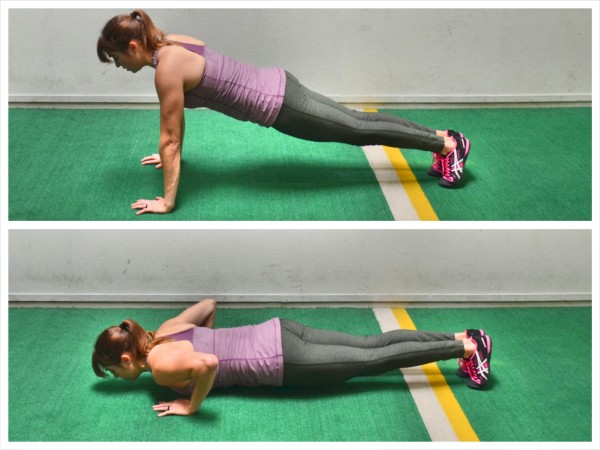
Plank Jacks – To do Plank Jacks, start at the top of a push up with your hands under your shoulders and your feet together. Your body should be in a nice straight line from your head to your heels. Brace your abs then jump your feet out wide to each side as if doing a Jumping Jack. Quickly jump them back in together. Repeat, jumping them back out. Keep your core engaged as you jump your feet in and out. Do not let your butt go up in the air or your hips sag as you jump your feet out wide and then back together. Beginners may need to start by stepping one foot at a time out wide and then back together.
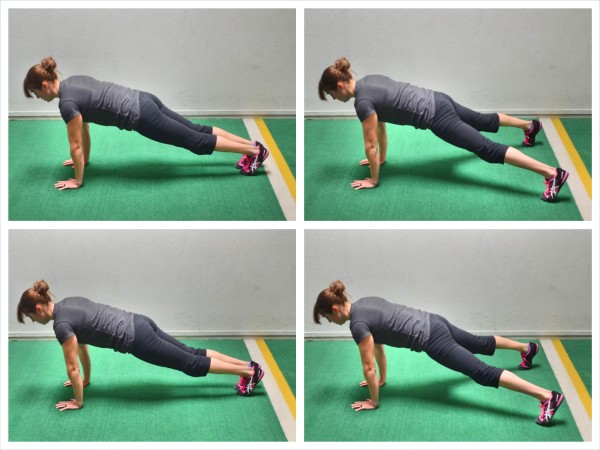
Alternating Leg V-Ups – To do Alternating V-Ups, lie flat on your back with your legs out straight in front of you and your arms down by your sides. Lift one leg up toward the ceiling and then lift your other leg up off the ground, squeezing your glute. Press your low back into the ground and engage your abs as you lift your legs up. Then crunch your upper body up as you reach your opposite arm up toward the toes of your raised leg. Press lightly through your arm on the ground as you press your low back into the ground and reach up as high as you can, rotating toward that raised leg. Squeeze your glute of the leg close to the ground to help protect your low back. Do not touch that leg down on the ground. Keep it up higher to make the move easier. Then lower the raised leg as you lift the other leg up toward the ceiling and crunch up to reach up toward that opposite foot. Keep alternating sides. Make sure to keep your low back firmly pressed into the ground as you reach up as high as possible while keeping your legs as straight as possible. Beginners may need to touch one leg down to the ground instead of keeping it up off the ground. They may also need to bend their knees more. Move quickly, crunching up as high as you can.

